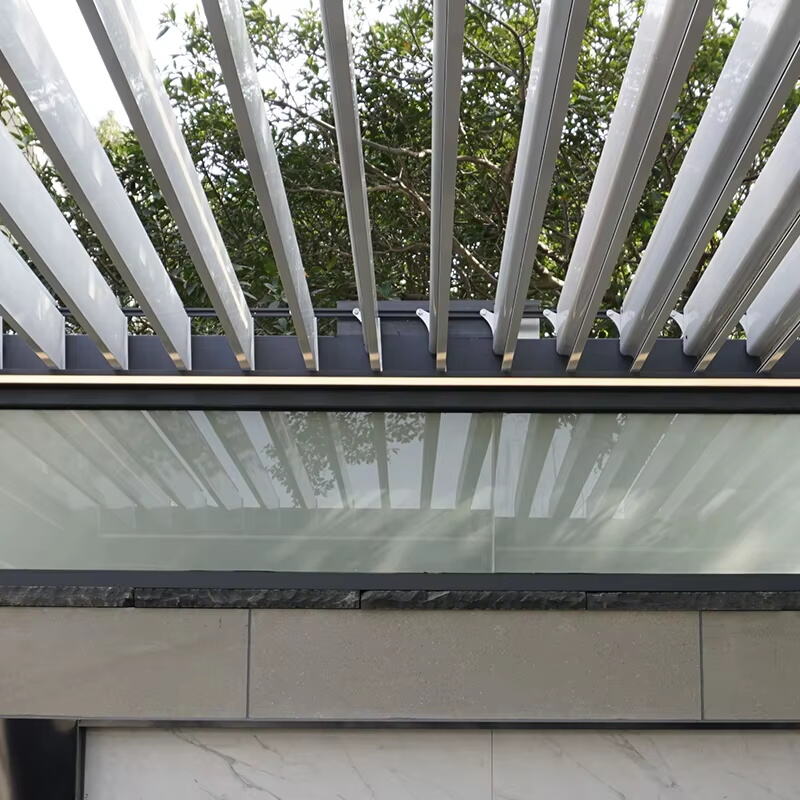Akıllı Pencerelerle Modern Yaşam Alanlarını Dönüştürmek
Akıllı ev teknolojisinin gelişimi, yaşam alanlarımızla etkileşimimizi kökten değiştirdi ve elektrikli perdeler bu dönüşümün ön saflarında yer alıyor. Bu yenilikçi pencere örtüleri, işlevselliği zarafetle sorunsuz bir şekilde birleştirerek ev sahiplerine ortamları üzerinde öncekine kıyasla çok daha fazla kontrol imkanı sunar. Daha fazla hane, ev otomasyonunu benimsedikçe elektrikli perdeler modern akıllı ev ekosisteminin vazgeçilmez bir parçası haline gelmiştir ve artan konfor, enerji verimliliği ve sofistike ortam yönetimi imkanları sunmaktadır.
Bugünün elektrikli perdeler geleneksel pencere örtüleri ile son teknolojiyi birleştiren mükemmel çözümü temsil eder. Basit uzaktan kumandalarından gelişmiş akıllı ev sistemlerine kadar çeşitli arayüzler aracılığıyla otomatik kontrol imkanı sunar ve hem konutlarda hem de ticari alanlarda giderek daha popüler bir tercih haline gelmiştir. Bu sistemlerin entegrasyon özellikleri büyük ölçüde genişledi; kullanıcıların günlük rutinlerine ve tercihlerine göre tepki veren, mükemmel şekilde senkronize olmuş ortamlar oluşturmalarına olanak sağlamaktadır.

Akıllı Ev Entegrasyon Kapasiteleri
Sesle Kontrol Sistemleri
Elektrikli perdelerin sesle kontrol edilen asistanlarla entegrasyonu, pencere örtüleriyle olan ilişkimizi kökten değiştirmiştir. Amazon Alexa, Google Assistant ve Apple HomeKit gibi popüler platformlar, artık elektrikli perdelerin kontrolünü basit ses komutları aracılığıyla sorunsuz bir şekilde gerçekleştirmemizi sağlar. Eve girip, "Hey Alexa, oturma odasındaki perdeleri indir" dediğinizde pencere örtülerinizin otomatik olarak tercih ettiğiniz pozisyona geldiğini hayal edin.
Sesli kontrol entegrasyonu, temel yukarı ve aşağı komutlarının ötesine geçer. Kullanıcılar, günün farklı saatlerinde güneş panellerini belirli konumlara ayarlamak veya bunları diğer akıllı ev cihazlarıyla koordine etmek gibi birden fazla eylemi birleştiren karmaşık rutinler oluşturabilir. Bu elden boş geçen işlem, hareket kabiliyeti sınırlı olanlar veya aynı anda birden fazla görevi yönetmek zorunda olanlar için ekstra bir konfor katmanı sunar.
Mobil Uygulama Kontrolü
Modern elektrikli güneşlik sistemleri, akıllı telefonunuzu güçlü bir kontrol merkezine dönüştüren özel mobil uygulamalarla birlikte gelir. Bu uygulamalar, evinizdeki tekil veya gruplandırılmış güneşlikleri yönetmek için sezgisel arayüzler sağlar. Kullanıcılar, özel zamanlamalar oluşturabilir, konumları hassas bir şekilde ayarlayabilir ve internet bağlantısı olan dünyanın herhangi bir yerinden pencere örtülerinin durumunu izleyebilir.
Gelişmiş mobil uygulamalar, kullanıcıların farklı aktiviteler veya günün farklı saatleri için tercih ettikleri perde pozisyonlarını kaydedebilecekleri sahne oluşturma özellikleri içerir. Örneğin, medya odasındaki tüm perdeleri karanlık bir izleme ortamı yaratmak üzere indiren "Film Zamanı" adlı bir sahne veya uyku odasındaki perdeleri güneşin doğuşunu taklit eder şekilde yavaşça açan "Sabah" adlı bir sahne tanımlayabilirsiniz.
Enerji yönetimi entegrasyonu
Otomatik Sıcaklık Kontrolü
Elektrikli perdeler, akıllı ev enerji yönetimi sistemlerinde önemli bir rol oynar. Sıcaklık sensörleri ve akıllı termostatlarla entegre olarak bu otomatik pencere örtüleri, gün boyunca iç mekanlarda ideal sıcaklıkları korumaya yardımcı olabilir. Yaz aylarında odalar fazla ısındığında perdeler otomatik olarak inebilir, güneşten gelen ısı yükünü azaltabilir ve klima sistemlerinin çalışmasına olan yükü hafifletebilir.
Sistem, mevsimsel değişiklikleri ve günlük hava desenlerini anlama konusunda zeki yapıya sahiptir. İleri algoritmalar, güneş konumu, dış sıcaklık ve iç konfor tercihleri gibi faktörlere göre perdeleri ne zaman ayarlaması gerektiğini tahmin edebilir. Bu da yıl boyunca önemli enerji tasarrufu ve artan konfor seviyeleri sağlar.
Işık Seviyesi Optimizasyonu
Doğal ışık yönetimi, entegre elektrikli perde sistemlerinin bir diğer önemli faydasıdır. Işık sensörleri, farklı aktiviteler için ideal aydınlatma seviyesini korurken mobilyaları ve sanat eserlerini zararlı UV ışınlarından korumak amacıyla otomatik ayarlamalar yapabilir. Bu akıllı işlev, gündüz saatlerinde yapay aydınlatmaya olan bağımlılığı azaltarak hem enerji tasarrufuna hem de artan refah düzeyine katkı sağlar.
Profesyonel kurulumar, mekânların gün boyu uygun doğal ışık almasını sağlamak ve mahremiyet ile konforu korumak amacıyla genellikle ışık haritalamasını içerir. Sistem, bulut örtüsü veya mevsimsel ışık değişimleri gibi değişen koşullara otomatik olarak ayarlanabilir ve iç mekânlarda ışık seviyesinin tutarlı kalmasını sağlar.
Güvenlik ve Mahremiyet Özellikleri
Otomatik Zamanlama Programlaması
Elektrikli panjurlar, sakinler evde yokken doluluk durumunu simüle eden programlanabilir zamanlamalarıyla ev güvenliğine önemli ölçüde katkıda bulunur. Akıllı ev güvenlik sistemleriyle entegrasyon, panjurların normal günlük aktiviteleri yansıtan düzende çalışmasını sağlayarak, dolu bir ev görünümü yaratarak potansiyel davetsiz misafirleri caydırır.
Bu güvenlik özellikleri, hareket sensörlerine ve güvenlik kameralarına bağlanarak daha da geliştirilebilir; özellik, mülk çevresinde tespit edilen harekete yanıt olarak perde ve panjurları otomatik olarak ayarlayabilir. Sistem ayrıca, güvenlik sistemleri aktif edildiğinde veya gün batımında perde ve panjurların otomatik olarak kapatılması için programlanabilir; bu da mahremiyet ve koruma açısından ek bir güvenlik katmanı sağlar.
Uzaktan İzleme Yetenekleri
Modern elektrikli perde ve panjur sistemleri, ev sahiplerinin herhangi bir yerden pencerelik örtülerini kontrol etmesine ve ayarlamasına olanak tanıyan kapsamlı uzaktan izleme imkanları sunar. Bu özellik, özellikle seyahat dönemleri veya ikinci konutlar için değerlidir; böylece kullanıcılar, mülkler boş bırakıldığında bile güvenlik sağlayabilir ve enerji verimliliğini yönetebilir.
İleri düzey sistemler, güvenlikle ilgili olarak anormal aktiviteler veya sistem durumu güncellemeleri hakkında bildirimler gönderebilir; bu da ev sahiplerinin mülklerinin güvenliği konusunda bilgilendirilmesini sağlar. Akıllı ev hub'larıyla entegrasyon ise merkezi kontrol ve izleme imkanı sunarak büyük mülklerdeki birçok pencere örtüsünün yönetimini kolaylaştırır.
Sıkça Sorulan Sorular
Elektrikli perdeleri mevcut akıllı ev sistemleriyle entegre etmek ne kadar zordur?
Entegrasyonun zorluğu, mevcut akıllı ev kurulumunuza ve seçtiğiniz elektrikli perde sistemine bağlı olarak değişir. Modern elektrikli perdelerin çoğu, uyumluluk göz önünde bulundurularak üretilir ve Z-Wave veya Zigbee gibi standart protokoller aracılığıyla popüler akıllı ev platformlarıyla entegre edilebilir. Profesyonel kurulum hizmetleri genellikle sistem entegrasyonunu ve mevcut akıllı ev altyapınızla sorunsuz bir şekilde çalışmasını sağlamak için programlamayı içerir.
Elektrik kesintisi sırasında elektrikli perdeler ne olur?
Birçok elektrikli perde sistemi, kesintili elektrik kesintileri sırasında çalışmayı sağlayan, örneğin akü paketleri veya kesintisiz güç kaynakları gibi yedek güç seçenekleriyle birlikte gelir. Bazı sistemler ayrıca manuel geçici çalışma özellikleri içerir; bu da elektrik kesildiğinde bile perdeyi ayarlayabilmenizi sağlar. Elektrikli perde sistemi seçerken, tüm durumlarda kesintisiz çalışma sağlamak için tedarikçinizle yedek güç seçeneklerini görüşmeniz önemlidir.
Elektrikli perde programlanarak belirli çevresel koşullara yanıt verebilir mi?
Evet, modern elektrikli perdeler, sıcaklık, ışık seviyesi, günün saati ve hava koşulları gibi çeşitli çevresel faktörlere otomatik olarak yanıt verecek şekilde programlanabilir. Uygun sensörler ve akıllı ev sistemleriyle entegre edildiğinde, perdeleriniz önceden ayarlanmış parametrelere göre kendilerini ayarlayabilir; bu da evinizin konforunu ve enerji verimliliğini manuel müdahale olmadan optimize eder.

